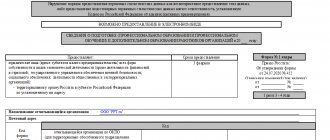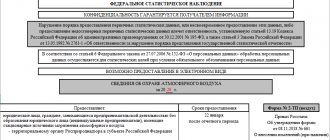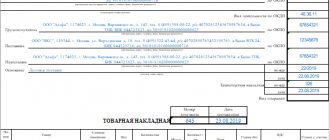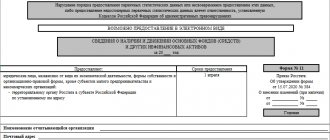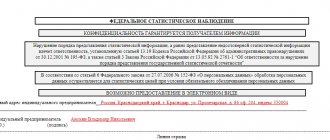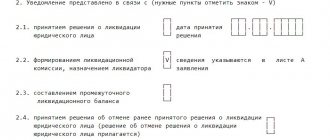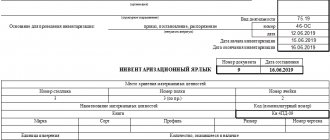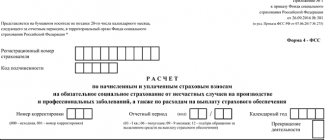The designation P-1 encrypts a report on the production and shipment of products or sales of services. This type of document is sent to the statistical authorities. Although not all, but quite a few enterprises are required to submit it. Moreover, if the company that must fill out these reports has separate divisions, it is also necessary to fill out a separate P-1 form for them. The report must be submitted no later than the 4th day of the month following the reporting month.
Organizations operating in the field of small business, insurance companies, banking and financial institutions, etc. are exempt from reporting.
- Form and sample
- Free download
- Online viewing
- Expert tested
FILES
Basic rules for filling out the document
The report can be divided into several sections:
- title page,
- main information block,
- certifying part.
All main sections are presented in the form of tables, where specific digital indicators are entered.
When filling out the document, you should be guided by background information and various explanations that are given in the report form, and it would also be useful, at least superficially, to familiarize yourself with some types of all-Russian classifications, the codes of which are used in the report.
This type of reporting refers to regular documents (must be submitted once a month) and all data is entered into it at the end of the reporting period.
If there is a reorganization or closure (liquidation) of a company obligated to provide a P-1 report, then it must be prepared for the entire period of work in the reporting period, up to the moment of reorganization or closure.
Those companies that were temporarily not engaged in their activities during the reporting period are required to provide a document on a general basis, but with a note indicating exactly when they did not work (i.e., indicating specific dates).
Instructions for filling out form N P-1 (CX)
font size
ORDER of Rosstat dated 08/09/2012 441 ON APPROVAL OF STATISTICAL INSTRUMENTS FOR THE ORGANIZATION OF FEDERAL STATISTICAL... Relevant in 2021
1. Federal statistical observation form N P-1 (SH) is provided by legal entities of all forms of ownership engaged in agricultural activities (in accordance with the All-Russian Classifier of Types of Economic Activities (OKVED) codes 01.1, 01.2, 01.3, 01.4), except for small businesses and peasant (farm) farms.
Bankrupt organizations where bankruptcy administration has been introduced are not exempt from providing information in the specified form. Only after the arbitration court has issued a ruling on the completion of bankruptcy proceedings in relation to the organization and an entry on its liquidation has been made in the unified state register of legal entities (clause 3 of Article 149 of the Federal Law of October 26, 2002 N 127-FZ “On Insolvency (Bankruptcy)” the organization - the debtor is considered liquidated and is exempt from providing information in the specified form.
2. A legal entity fills out this form and submits it to the territorial body of Rosstat at its location.
If a legal entity has separate divisions, this form is filled out both for each separate division and for a legal entity without these separate divisions.
The completed forms are submitted by the legal entity to the territorial bodies of Rosstat at the location of the corresponding separate division (for a separate division) and at the location of the legal entity (without separate divisions). In the event that a legal entity (its separate division) does not carry out activities at its location, the form is provided at the place where they actually carry out activities.
The head of a legal entity appoints officials authorized to provide statistical information on behalf of the legal entity.
3. The address part indicates the full name of the reporting organization in accordance with the constituent documents registered in the prescribed manner, and then the short name in brackets. The form containing information on a separate division of a legal entity indicates the name of the separate division and the legal entity to which it belongs.
The line “Postal address” indicates the name of the subject of the Russian Federation, legal address with postal code; if the actual address does not coincide with the legal address, then the actual postal address is also indicated. For separate divisions that do not have a legal address, a postal address with a postal code is indicated.
A legal entity enters the code of the All-Russian Classifier of Enterprises and Organizations (OKPO) in the code part of the form on the basis of the Notification of assignment of the OKPO code sent (issued) to organizations by the territorial bodies of Rosstat.
For territorially separate subdivisions of a legal entity, an identification number is indicated, which is established by the territorial body of Rosstat at the location of the territorially separate subdivision.
4. When reorganizing or liquidating a legal entity, statistical information in Form N P-1 (SH) is provided for the period of activity in the reporting period until the moment of liquidation (reorganization).
5. In cases of using land, livestock and poultry on a lease basis, the tenant provides a statistical report on the production and shipment of agricultural products to the territorial body of state statistics at the location of the land, livestock and poultry.
6. Information on the sowing of spring crops, the progress of harvesting agricultural crops, as well as on the sowing of winter crops and plowing of plowed land is provided on an accrual basis at the end of the reporting month; on the volume of livestock products produced, the shipment of agricultural products - for the reporting month, and the export of products - for the reporting quarter of the current year.
7. In column 4, on lines 1 - 11 and on line 65 in the section For reference, during the sowing period of spring crops, the area sown with spring crops as of the reporting date without the reseeding area for dead winter and perennial grasses, but including the remaining areas of spring crops, is shown on an accrual basis, sown before winter (sunflower, vegetables, etc.).
In the event of the death of spring crops and their reseeding with spring crops, the area of the lost crops of the original crop is excluded from the report in the amount of reseeding, and as of the reporting date, the report includes the area of sowing of those crops with which the dead crops were reseeded. The areas of unseeded dead spring crops are not excluded from the report.
Lines 69 - 70 show the area of death of winter crops, confirmed by relevant documents.
8. Starting from the report as of July 1 and up to November 1 inclusive, columns 4 - 5 along lines 1 - 12 show data on the progress of harvesting agricultural crops on an accrual basis at the end of the reporting month.
Lines 1, 2 show data on grain crops / without corn / (wheat, spelt, rye, meslin (a mixture of wheat and rye), barley, oats, rice, buckwheat, millet, sorghum, triticale, other grains) and legumes (peas , beans, lentils, chickpeas, china, mung beans, broad beans, vetch, lupine and other legumes for grain).
Column 4, line 1 shows the area of winter and spring grain and leguminous crops (without corn) mowed for grain; on line 2 - the area from which grain and leguminous crops were threshed (without corn); on lines 3 and 4 - the mown and threshed area of wheat (winter and spring), respectively.
Line 11 in column 5 during the harvesting period (from July 1 to November 1) takes into account the products of fully harvested vegetable crops (without seeds) from open ground, as well as the products of partial harvesting of vegetables before and after mass harvesting.
Line 12 in column 5, starting with the report for January, shows the cumulative total of the production of all vegetables (open and protected ground).
9. Line 71 of the form reflects the area of grain and leguminous crops (without corn), recorded in form N 4-СХ at the end of spring sowing and then died in the summer. Crops that died in the spring and were replanted with another crop recorded in form N 4-СХ are not shown on line 71. The area of dead crops must be confirmed by relevant documents on the death.
Line 72 shows the area of individual areas of crops intended for grain in the spring, but actually harvested and used for feed purposes.
Line 73 shows the area cultivated using various basic tillage technologies in the fall after harvest and intended for sowing crops in the spring of next year.
The area prepared for plowing, on which spring crops were sown in winter, is not excluded from the total cultivated area for plowing. Plowing the potato field to collect the remaining tubers is included in line 73.
10. Lines 74, 75 show the area sown with winter crops for next year’s harvest.
11. Line 82 reflects the total amount of grain used for processing for feed purposes (for compound feed, dirt, feed flour and other feed products), food purposes (for flour and cereals) and other products (alcohol, beer, starch and other types ).
12. Column 5 on lines 15 - 25 reflects the production of livestock products.
Lines 15 - 20 record the live weight of livestock and poultry (including those received from raising and purchasing from households under contracts), both sold for slaughter and slaughtered on their own farm. Young livestock sold for further reproduction is not taken into account in these lines.
13. Line 21 takes into account all cow milk produced from all cows of the dairy and beef herd, barn cows, fattening and fattening cows, calving heifers, buffaloes, yak cows, as well as milk milk and colostrum spent on feeding young animals. Milk sucked by calves is not counted.
14. Lines 27 - 30 reflect data on the number of livestock and poultry raised in an agricultural organization, defined as the sum of the live weight of the offspring, the increase in young animals and the gain in fattening livestock, as well as the gain from raising livestock and poultry on public farms under contracts, received for the reporting period. period, minus the weight of dead livestock and poultry.
15. Column 6 reflects the shipment of agricultural products of own production, both on its territory and abroad through all distribution channels, including products shipped through barter transactions (i.e., by exchanging agricultural products for industrial products or consumer goods ). The volume of agricultural products shipped through barter transactions also includes products sold to pay off debts for electricity, equipment, fertilizers, trade credit, etc.
Column 6 shows the actual shipped products, regardless of whether they have been paid for or not.
Agricultural products and raw materials submitted for processing on a toll basis are included in the report as finished products (vegetable oil, sugar, etc.) obtained by the agricultural organization from processing are shipped, in terms of agricultural raw materials. Before receiving finished products, raw materials shipped to processing organizations are not included in the report.
16. Column 7 provides indicators on the availability of products at the end of the reporting month. The volume of production includes products both of our own production and those received from outside (purchased, received on toll terms or in exchange).
17. The section on the export of agricultural products shows products of own production exported by the agricultural organization through all distribution channels outside the constituent entities of the Russian Federation, as well as outside the Russian Federation, regardless of whether the products were exported by the agricultural organization itself or by the buyer. Data is recorded indicating the territories to which the products were exported.
Logical and arithmetic controls:
| page 1 gr. 4 | > = | page 2 gr. 4 | page 15 gr. 5 | = | page (16 + 17 + 18 + 19 + 20) gr. 5 |
| page 1 gr. 5 | > = | page 2 gr. 5 | page 15 gr. 6 | = | page (16 + 17 + 18 + 19 + 20) gr. 6 |
| page 3 gr. 4 | > = | page 4 gr. 4 | page 15 gr. 7 | = | page (16 + 17 + 18 + 19 + 20) gr. 7 |
| page 3 gr. 5 | > = | page 4 gr. 5 | page 76 gr. 3 | > = | pp. (77 + 78 + 79 + 80 + 81) gr. 3 |
| page 12 gr. 5 | > = | page 11 gr. 5 |
Detailed methodological recommendations for filling out the indicators of sections 1 - 5 of the form are set out in the Instructions for filling out the federal statistical observation form N P-1 (SH) “Information on the production and shipment of agricultural products, approved by Rosstat order of October 15, 2009 N 227.
Appendix No. 9
—
Title page
One of the subtypes of form P-1 is a report on the production and sale of agricultural products , which will be considered in the example of filling out the document.
The first step is to draw up a title page on which the reporting period is written (name of month and year), as well as information about the reporting enterprise: full name (according to the constituent documents), its address: legal and postal address, if they differ from each other (indicating the index ). The OKPO code (All-Russian Classifier of Enterprises and Organizations) and the OKVED code (All-Russian Classifier of Economic Activities) are also entered here - this data can also be found in the company’s registration papers.
Composition of the form and filling procedure
The title page and 5 sections are the composition of the P-1 report.
The title page includes the name, address and OKPO of the organization.
Section 1
All figures are given without VAT.
When filling out the first section, please note that:
- Line 01 does not include income from the sale of fixed assets, intangible assets, inventories, currency, and securities;
- lines 03–05 need to be completed only in reports for March, June, September and December;
- line 05 reflects the balances of purchased goods (you can use the balance sheet for account 41, taking the final balance of the account).
Section 2
All section indicators are taken without VAT.
The data in this section is a detailed transcript of line 01 of section 1 and reflects information about the products (services) of its production.
The number of rows in the tabular part of section 2 corresponds to the number of OKVED codes used at the enterprise.
The sum of all lines of section 2 must be equal to the amount indicated in line 01 in the corresponding columns.
Fill out and submit the P-1 form without errors and right now! For you 3 months of Kontur.Externa as a gift.
Try it
Section 3
All figures include VAT.
On line 22 you need to show the proceeds from the sale of goods to the public for personal use.
From the calculation on line 22 you need to exclude:
- goods received by employees as payment for labor;
- goods that did not meet the warranty period;
- travel and lottery tickets;
- real estate objects;
- coupons for all types of transport;
- telephone cards and express payment cards for communication services.
Lines 23–25 are filled in according to their name.
In line 26, organizations need to show revenue from the sale of purchased goods to organizations and individual entrepreneurs. Goods sold to the public are not included in line 26.
Line 27 reflects revenue from own culinary products sold to the population and purchased goods without culinary processing.
Section 4
This section reflects information about the transportation of goods by car.
Lines 29 and 30 are filled in in tons, and lines 31 and 32 in ton-kilometers.
Freight turnover is calculated in ton-kilometers.
Freight turnover = (weight of cargo on trip No. 1 x transportation distance on trip No. 1) + (weight of cargo on trip No. 2 x transportation distance on trip No. 2) + the product of the indicated indicators for each individual trip. The number of terms depends on the number of trips made.
Section 1
This section of the form contains information about the movement of agricultural products . The first column of the table contains the name of the indicator (number one - plants, number two - animals and poultry), the second - line number, and the third - OKPD 2 code (All-Russian Classifier of Products by Type of Economic Activity).
Next are four columns, which include information about the movement of products, which refers to such actions of agricultural producers as sowing, production, shipment and balances. If something is not clear, then below the table, in the form of a short reference, explanations are given for some of the concepts used in the document.
Section 2
The second section of the report records data on the number (i.e., quantity) of animals and poultry on the farm (for each species separately), as well as on the availability of feed (those listed in the first column of the previous section).
It should be noted that in form P-1, under the second section, there is a reference and information block where data on the results of agricultural activities are entered on an accrual basis at the end of the reporting period.
Results
Rosstat, analyzing the state of the agricultural sector of the Russian economy, collects statistical reports from agricultural enterprises in the status of legal entities, revealing a number of key economic indicators. For these purposes, form P-1 CX .
You can learn more about reporting documents for Rosstat in the articles:
- “Find out what kind of statistical reporting and in what time frame you must submit”;
- “Information on financial investments - statistics form P-6.”
You can find more complete information on the topic in ConsultantPlus. Free trial access to the system for 2 days.
Sections 3 and 4
The table in section number three contains information on the consumption of various feeds for feeding animals and poultry, as well as on the amount of cereal crops processed for these purposes.
Next comes the fourth section, which contains data on the export of produced agricultural goods (cereals and livestock products), including outside the country. If the goods were not shipped during the reporting period, this part of the document does not need to be filled out.
Signing Form P-1
All information entered in the document must be certified by the employee responsible for its accuracy. Most often, this is the head of the enterprise and his position (director, general director) is entered in the corresponding table at the end of the report, and a signature is also placed with a mandatory decoding.
His contact details should also be indicated (in case the specialist receiving the documents has any questions) and the date the document was issued.
